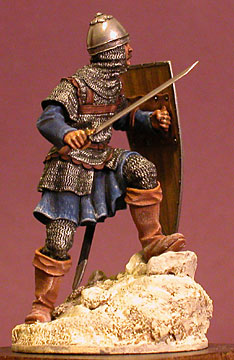|
Pegaso 54mm metal
Byzantine Infantryman
by
Glen
Phillips
|
 |
|
Byzantine Infantryman |

HyperScale is proudly supported by Squadron.com
|
Summary |
|
Subject |
Byzantine
Infantryman |
|
Manufacturer |
Pegaso |
|
Scale |
54mm |
|
Medium |
Metal |
|
Paint |
Andrea
Acrylics |
I picked this figure up from a vendor at a local model show.
The vendor had two tables covered with Verlinden and Warriors
figures, mostly 20th century pieces, and there in a sea of camouflage
green was a lonely blue box: Pegaso’s Byzantine Infantryman.
My reaction was similar to that of the seagulls in ‘Finding Nemo’ -
Mine, mine, mine, mine, mine…
Preparation
and Construction
|
 Pegaso’s
54mm Byzantine Infantryman is a well sculpted and cleanly cast (with two
minor exceptions) metal figure. Clean up was minimal and the fit was
excellent. Pegaso’s
54mm Byzantine Infantryman is a well sculpted and cleanly cast (with two
minor exceptions) metal figure. Clean up was minimal and the fit was
excellent.
The minor exceptions concerned the sword and scabbard. The sword was
straight and slightly misshapen at the blade tip, while the scabbard was
curved. I cleaned up the excess metal at the tip and re-sharpened the
blade. Since I felt more comfortable straightening the thicker scabbard
than bending the thinner blade, I opted for the former.
The figure’s helmet, sword blade, scabbard tip, and shield rim were
buffed with a motor-tool; the remainder of the piece - including the
base - was primed using Floquil Grey Primer, thinned with lacquer
thinner, and applied with a brush.
|
Home
| What's New |
Features |
Gallery |
Reviews |
Reference |
Forum |
Search